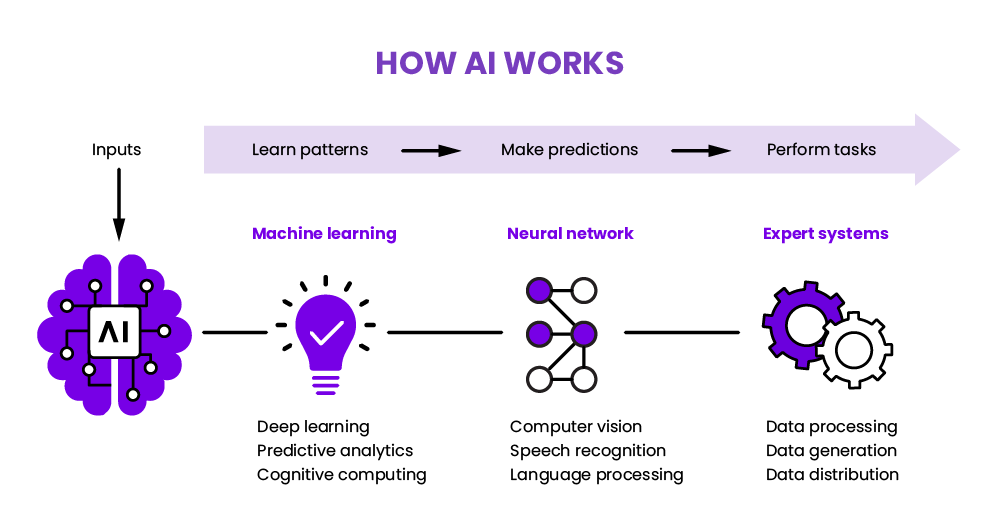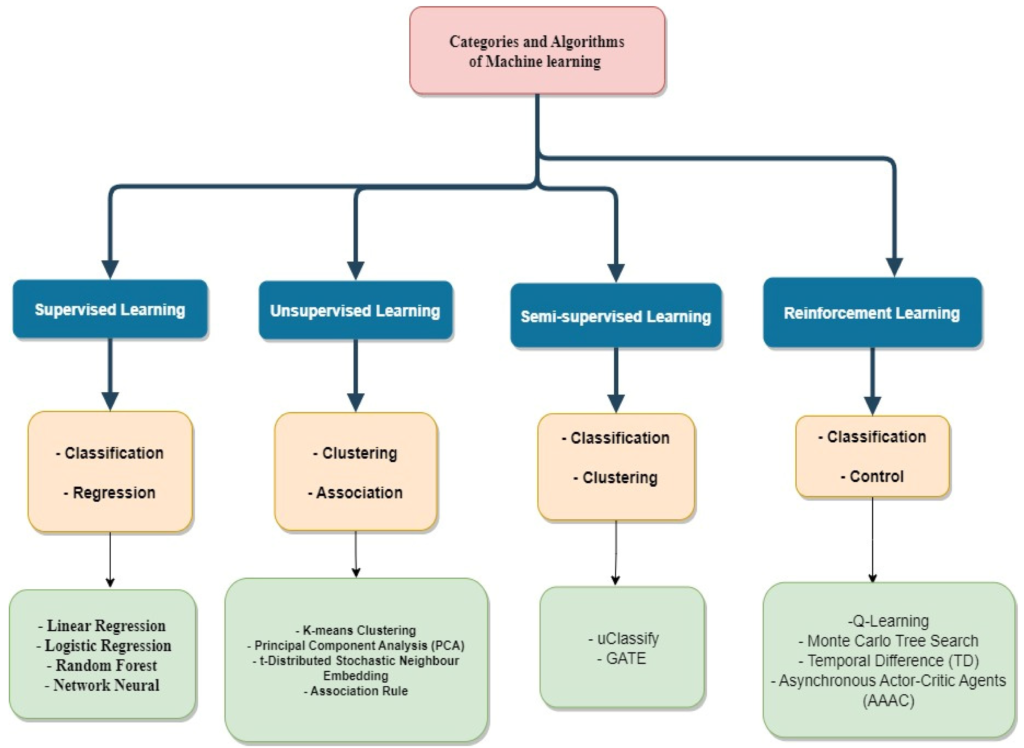Machine learning, often abbreviated as ML, is a captivating field that combines the realms of computer science and artificial intelligence. At its core, ML revolves around the idea of teaching computers to learn from data and make decisions or predictions based on that acquired knowledge. In this in-depth beginner’s guide, we are set to unravel the mysteries of machine learning, explore its wide-ranging applications, and provide you with the essential knowledge to embark on your own ML journey with confidence.
Understanding the Essence of Machine Learning
Let’s start at the very beginning. What exactly is machine learning?
ML stands as a subset of artificial intelligence (AI), focusing on the development of algorithms and models that enable computers to improve their performance on specific tasks by learning from data. Unlike traditional programming, where explicit instructions are provided, ML systems learn and adapt independently. In essence, it’s about creating intelligent systems that can automatically learn and improve from their experiences, much like how humans learn from their mistakes and successes.

Key Concepts in Machine Learning: Building Blocks for Understanding
Before we delve deeper into the world of ML, let’s establish a solid foundation by exploring key concepts that form the bedrock of this fascinating field.
- Data: The Fuel of ML
Data is the lifeblood of machine learning. It can encompass a wide array of information, ranging from numerical data and text to images and audio. In the realm of ML, these data sets serve as the training ground for models, where patterns and insights are extracted and utilized for making predictions or decisions.
- Algorithms: The Brains Behind ML
Algorithms are the driving force behind machine learning. They are sets of rules, techniques, and statistical methods that guide computers in performing specific tasks, be it recognizing patterns in images, translating languages, or making financial predictions.
- Training and Testing: The Crucial Phases
Machine learning models undergo two significant phases: training and testing. During training, the model learns patterns from labeled data, much like how a student learns from textbooks. Subsequently, the model is tested on unseen data to assess its performance, ensuring it can generalize its learnings effectively.
- Types of Machine Learning: Supervised, Unsupervised, and More
ML can be categorized into different types based on learning styles. Supervised learning involves training models with labeled data, while unsupervised learning explores data without predefined labels. Reinforcement learning, on the other hand, focuses on decision-making through trial and error, similar to how humans learn.
- Deep Learning: The Power of Neural Networks
Deep learning is a subset of machine learning that harnesses the capabilities of artificial neural networks. With multiple layers (hence “deep”), these networks excel in handling complex tasks, such as image recognition, natural language processing, and autonomous driving.
- Overfitting: Striking the Right Balance
Overfitting is a common challenge in machine learning. It occurs when a model becomes too specialized in its training data, losing the ability to generalize well to new, unseen data. Balancing a model’s complexity to prevent overfitting is a crucial aspect of ML.

Real-World Applications: Where ML Meets Everyday Life
Machine learning has permeated our daily existence, often working quietly in the background to enhance our experiences and provide practical solutions. Here are some real-world examples:
– Recommendation Systems: Personalized Content
Streaming platforms like Netflix and music apps like Spotify rely on machine learning algorithms to analyze user behavior and suggest content that matches individual preferences, enhancing user engagement.
– Virtual Assistants: Conversational Companions
Virtual assistants such as Siri, Alexa, and Google Assistant utilize natural language processing and machine learning to comprehend and respond to voice commands, simplifying tasks and providing information on the go.
– Email Spam Filters: A Clean Inbox
Email providers employ ML algorithms to identify and filter out spam emails. By recognizing patterns and characteristics of spam, these filters help ensure that your inbox remains clutter-free.
– Online Shopping: Tailored Recommendations
E-commerce giants employ machine learning to offer personalized product recommendations based on your browsing and purchase history. These tailored suggestions enhance the shopping experience and drive sales.
Embarking on Your Machine Learning Journey
If you’ve been captivated by the possibilities of machine learning and wish to commence your own journey, here’s a roadmap to set you on the right path:
1. Learn Python: The Language of ML
Python is the lingua franca of machine learning. Its extensive libraries, including TensorFlow and scikit-learn, simplify the implementation of ML models. Begin by mastering Python’s fundamentals. Dive into variables, data types, loops, and functions. Familiarize yourself with Python’s libraries and tools that are specifically designed for machine learning tasks. Learning Python is your first step toward becoming proficient in machine learning.
2. Grasp the Mathematical Fundamentals
Machine learning leans heavily on mathematics, particularly linear algebra, calculus, and statistics. A solid understanding of these concepts is essential for creating and comprehending ML algorithms. Delve into linear algebra to grasp the concepts of vectors and matrices, which are fundamental for various ML techniques. Explore calculus to understand how derivatives and integrals play a role in optimizing machine learning models. Statistics is the bedrock for making sense of data, so ensure you have a firm grasp of statistical concepts, including probability distributions, hypothesis testing, and regression analysis.
3. Explore Online Courses
Numerous online platforms, such as upGrad, Coursera, edX, and Udacity, offer comprehensive courses in machine learning. These courses provide structured learning paths, practical exercises, and certification options. Enroll in courses that suit your skill level, whether you’re a beginner or have some programming experience. These courses often cover a wide range of topics, from supervised and unsupervised learning to deep learning and reinforcement learning. Make the most of these resources to gain a deep understanding of machine learning concepts and techniques.
4. Hands-On Practice
The most effective way to learn machine learning is by doing. Start with small ML projects, such as image recognition or simple predictive models, and gradually work your way up to more complex tasks. Use datasets available online or create your own for experimentation. Apply the concepts and techniques you’ve learned in Python and mathematics to solve real-world problems. Experiment with different ML algorithms and models, and fine-tune them for optimal performance. The more hands-on experience you gain, the more proficient you’ll become in the field of machine learning.
By following this roadmap, you’ll be well-equipped to embark on a rewarding journey into the world of machine learning, and with dedication and practice, you’ll be able to harness its power to tackle complex challenges and make meaningful contributions in this rapidly evolving field.




Thank you for the valuable information on the blog.I am not an expert in blog writing, but I am reading your content slightly, increasing my confidence in how to give the information properly. Your presentation was also good, and I understood the information easily.
For more information Please visit the 1stepGrow website or AI and data science course.